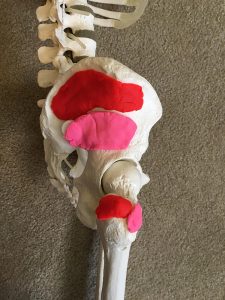Everybody knows the “glutes” are the largest muscle in the body. BUTT…they’re not just one muscle.
It’s time to meet the smallest glute! It seems like an oxymoron doesn’t it? small GLUTE.
The Three Glutes
Gluteus Maximus – 3
Gluteus Medius – 3
Gluteus Minimus – 2
In this article you’ll learn about the under-estimated gluteus minimus and how it “keeps the peace”. It’s the deepest and smallest of the three glutes, making it the most precise mover. Since the muscle fibers are shorter and fewer than it’s sibling, glute max and glute med, it can create more specific movement.
Gluteus Minimus Attachments
Both parts of your gluteus minimus attach to the anterior (front), superior (top) of the greater trochanter on your femur. This chunk of bone can be felt near the hip socket using your hand. The two parts divert to the lateral (side) surface of the ilium making what looks like a triangle.
The first section attaches to the anterior (front) facing part of the surface.
The second section travels to the medial (side) facing part of the surface.
In this photo of Andy the Skeleton, the pink play-doh represents the attachment sites for both sides of the gluteus minimus. Imagine the muscle fibers running from the top location to the bottom, they make what looks like a peace sign when you hold up two fingers. You could think of this muscle keeping the peace while the larger glutes create large movements…
Gluteus Minimus Function
This is small and simple muscle to explore when it comes to actions, just look at the attachments and remember….
- Muscles contract (shorten) when lengthened to keep the bones together.
- Muscles contract (shorten) to move bones when signaled by the brain.
Find the attachments on your own body using your fingers to locate the bony landmarks you see in the photo. Get familiar with the location of the muscle to enhance body awareness. Move your hip into abduction (to the side) and slight flexion (forward) to feel the attachments contract into your fingers. You might have to press a little deeper to feel the ilium attachment since it’s beneath gluteus medius.
What motions would cause gluteus minimus to shorten OR lengthen?
Gluteus Minimus Movements
- Abduction. Just like gluteus medius, this muscle aids in bringing the hip out to the side with less motion and more precision.
- Flexion. Because of the anterior attachment on the greater trochanter gluteus medius aids in hip flexion when walking, biking and climbing stairs.
- Internal rotation. This is also due to the anterior attachment on the greater trochanter.
Gluteus Minimus Exercises
These exercise all utilize many other muscles than the gluteus minimus. But, when performed slowly with attention on this smaller muscle, you might be able to feel it contract, especially if you stop and hold the position for a moment.
- Side kicks. Standing tall, bring your leg into abduction and add slight internal rotation or flexion to call upon the gluteus minimus.
- Marching. Hip flexion (lifting the thigh up) will engage gluteus minimus in the early phase of lifting your leg. Go slowly and pause at every inch to see if you can connect to it.
- Band walks. With a band around your ankles or thighs walk like a crab sideways slowly. Getting into a partial squat causes hip flexion which will utilize the gluteus minimus more specifically.
- Side lying leg lifts. Doing these with slight hip flexion or internal rotation like the kicks is also an effective way to work gluteus minimus.
Connect to the Gluteus Minimus
When you exercise, think about the attachments of the muscle. Visualize it shortening and lengthening. Do this by going more slowly through the motions. Remember, this muscle works with precision and when overridden by larger muscles it might not do much work at all. This is why doing smaller, isolated exercises as a part of your workout routine is smart to create more stability and balance in your body.
References:
Abrahams, P.H. et al. 2003. McMinn’s Color Atlas of Human Anatomy. London: Elseiver.
Muscolino, Joseph E. 2004. Musculoskeletal Anatomy Coloring Book. Philadelphia, PA: Mosby, Inc.
Beverly Hosford, MA teaches anatomy and body awareness using a skeleton named Andy, balloons, play-doh, ribbons, guided visualizations, and corrective exercises. She is an instructor, author, and a business coach for fitness professionals. Learn how to help your clients sleep better with in Bev's NFPT Sleep Coach Program and dive deeper into anatomy in her NFPT Fundamentals of Anatomy Course.




